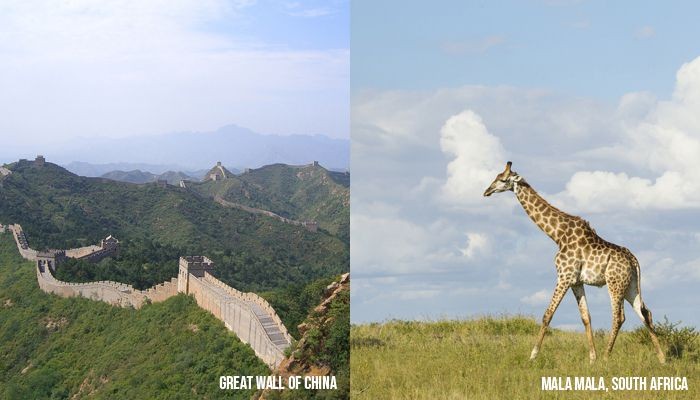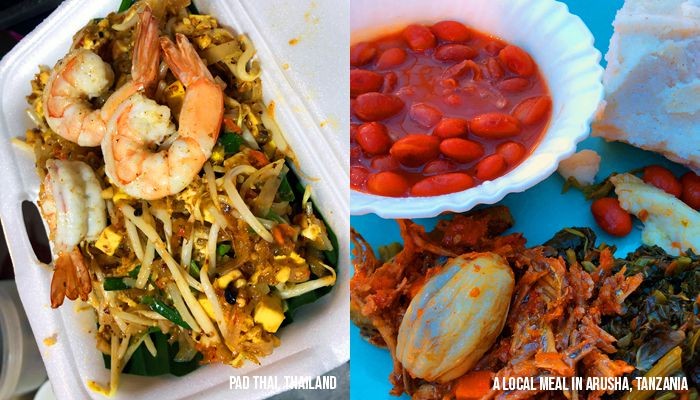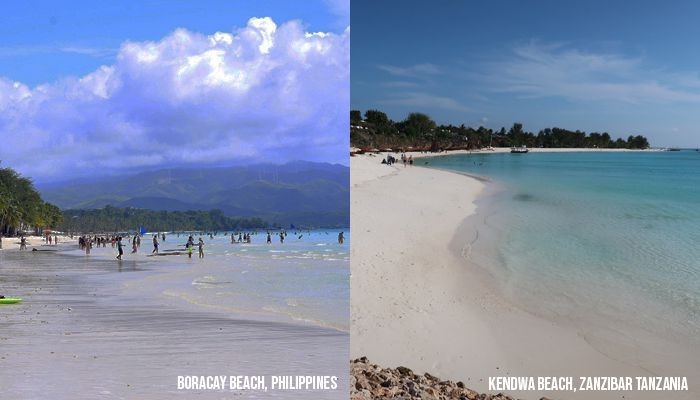Want to understand the geographical immensity of Africa in relation to Asia? COMPARE.EDU.VN provides a comprehensive comparison exploring landmass, cultural impacts, and economic influence between these two continents. Discover insightful comparisons, geographical facts, and relative data to fully grasp the scale of these regions, enhancing your understanding of continental sizes, and geographical comparisons.
1. Introduction: Africa and Asia – A Tale of Two Continents
Africa and Asia, two of the world’s largest continents, present fascinating contrasts and comparisons. Understanding “How Big Is Africa Compared To Asia” extends beyond simple landmass figures. It delves into population densities, economic influences, and cultural impacts. This comprehensive analysis, brought to you by COMPARE.EDU.VN, aims to provide a detailed comparison of these two continents, examining their geographic characteristics, economic strengths, and cultural richness. Ultimately, this comparison will showcase the size disparity, the impact on global affairs, and the distinct roles each continent plays in the world.
2. Geographical Size Comparison: Landmass and Dimensions
2.1. Africa: The Second Largest Continent
Africa, often referred to as the “Mother Continent,” covers approximately 30.37 million square kilometers (11.73 million square miles), including its islands. This vast landmass constitutes about 20% of the Earth’s total land area. Africa stretches approximately 8,000 kilometers (5,000 miles) from north to south and 7,400 kilometers (4,600 miles) from east to west. This immense area is home to diverse landscapes, ranging from the Sahara Desert in the north to the lush rainforests of the Congo Basin and the savannahs of East Africa.
2.2. Asia: The Largest Continent on Earth
Asia, the largest continent, dwarfs Africa in size, covering approximately 44.58 million square kilometers (17.21 million square miles). This accounts for about 30% of the Earth’s total land area and nearly 9% of the Earth’s total surface area. Asia extends about 8,700 kilometers (5,400 miles) from north to south and 9,600 kilometers (6,000 miles) from east to west. Its geographic diversity is unparalleled, featuring the highest mountains in the world (the Himalayas), vast deserts (the Gobi), extensive plains, and the longest coastline of any continent.
2.3. Visualizing the Size Difference
To better understand the scale of “how big is Africa compared to Asia,” consider this: Asia is about 1.5 times larger than Africa. This means that if you could overlay the African continent onto Asia, a significant portion of Asia would still remain uncovered. This difference in size has profound implications for population distribution, economic activity, and resource availability across both continents.
2.4. Comparative Table of Landmass and Dimensions
| Feature | Africa | Asia |
|---|---|---|
| Landmass | 30.37 million sq km (11.73 million sq mi) | 44.58 million sq km (17.21 million sq mi) |
| Percentage of Earth’s Land | 20% | 30% |
| North-South Extent | 8,000 km (5,000 miles) | 8,700 km (5,400 miles) |
| East-West Extent | 7,400 km (4,600 miles) | 9,600 km (6,000 miles) |





3. Population Dynamics: People and Density
3.1. Africa’s Population: Growth and Distribution
Africa’s population is approximately 1.4 billion people, distributed across 54 countries. Despite its large landmass, Africa has a relatively low population density compared to Asia. However, the continent is experiencing rapid population growth, with several countries having some of the highest growth rates in the world. This growth presents both opportunities and challenges, including the need for increased infrastructure, education, and healthcare.
3.2. Asia’s Population: The Most Populous Continent
Asia is home to over 4.7 billion people, accounting for nearly 60% of the world’s population. This vast population is distributed across 48 countries, with China and India being the most populous. Asia’s population density is significantly higher than Africa’s, particularly in regions like South Asia and Southeast Asia. The continent faces challenges related to urbanization, resource management, and environmental sustainability.
3.3. Population Density Comparison
The population density of Asia is approximately 108 people per square kilometer, while Africa has a density of about 43 people per square kilometer. This stark contrast influences various aspects, including agricultural practices, urban development, and resource utilization. In Asia, intensive farming and crowded urban centers are common, while Africa’s population is more dispersed, with many people living in rural areas.
3.4. Table of Population and Density
| Feature | Africa | Asia |
|---|---|---|
| Population | 1.4 billion | 4.7 billion |
| Number of Countries | 54 | 48 |
| Population Density | 43/sq km | 108/sq km |
4. Economic Influence: Trade and Development
4.1. Africa’s Economic Landscape: Opportunities and Challenges
Africa’s economy is diverse, with significant differences between countries and regions. While some nations, like South Africa and Nigeria, have relatively developed economies, many others face challenges such as poverty, corruption, and limited infrastructure. However, Africa is also rich in natural resources, including minerals, oil, and arable land, which present significant economic opportunities.
4.2. Asia’s Economic Powerhouse: Growth and Innovation
Asia is a global economic powerhouse, driven by the rapid growth of countries like China, India, and Japan. The continent is a major player in global trade, manufacturing, and technology. Asia’s economic success is attributed to factors such as high levels of investment in education and infrastructure, a strong work ethic, and a focus on innovation.
4.3. Comparative Economic Indicators
When comparing “how big is Africa compared to Asia” in terms of economic influence, several indicators stand out. Asia’s GDP is significantly larger than Africa’s, and its share of global trade is much higher. However, Africa has seen substantial economic growth in recent years, driven by factors such as rising commodity prices and increased foreign investment.
4.4. Key Economic Indicators Table
| Indicator | Africa | Asia |
|---|---|---|
| GDP (Nominal) | $2.7 trillion | $36 trillion |
| GDP Growth Rate | 3-5% | 5-7% |
| Major Industries | Agriculture, Mining | Manufacturing, Tech |
| Trade Volume | Lower | Higher |
5. Cultural Diversity: Traditions and Modernity
5.1. Africa’s Cultural Heritage: A Tapestry of Traditions
Africa is renowned for its rich cultural heritage, which is reflected in its diverse languages, traditions, and art forms. The continent is home to thousands of ethnic groups, each with its unique customs and beliefs. African culture emphasizes community, oral tradition, and spirituality, and has had a profound influence on art, music, and literature around the world.
5.2. Asia’s Cultural Mosaic: Ancient Roots and Modern Expressions
Asia’s cultural diversity is equally impressive, with a blend of ancient traditions and modern expressions. The continent is the birthplace of major religions such as Hinduism, Buddhism, and Islam, and its cultural heritage is reflected in its architecture, cuisine, and performing arts. Asia’s cultural traditions emphasize respect for elders, harmony, and discipline.
5.3. Comparing Cultural Influences
While both continents boast incredible cultural diversity, their global influences differ. Asian cuisine, music, and philosophies have spread worldwide, while African art, music, and oral traditions have had a significant impact on Western culture. Both continents are witnessing a revival of traditional practices amidst modernization.
5.4. Cultural Highlights Table
| Feature | Africa | Asia |
|---|---|---|
| Major Religions | Islam, Christianity | Hinduism, Buddhism, Islam |
| Cultural Emphasis | Community, Oral Tradition | Harmony, Respect for Elders |
| Global Influence | Art, Music, Literature | Cuisine, Philosophy, Music |
6. Climate and Environment: From Deserts to Rainforests
6.1. Africa’s Diverse Climates: A Continent of Extremes
Africa’s climate ranges from the arid Sahara Desert to the tropical rainforests of the Congo Basin and the temperate regions of South Africa. This diversity influences vegetation, wildlife, and agricultural practices across the continent. Climate change poses a significant threat to Africa, with rising temperatures, droughts, and floods affecting food security and livelihoods.
6.2. Asia’s Varied Climates: Monsoons and Mountains
Asia’s climate is equally varied, ranging from the Arctic conditions of Siberia to the tropical monsoons of Southeast Asia and the arid deserts of the Middle East. The Himalayas influence weather patterns across the continent, creating a rain shadow effect in some regions. Asia faces environmental challenges such as deforestation, air pollution, and water scarcity.
6.3. Climate Impact Comparison
Both continents are vulnerable to climate change, but the impacts differ. Africa faces increased droughts and food insecurity, while Asia is threatened by rising sea levels and extreme weather events. Sustainable development and climate resilience are critical for both regions.
6.4. Climate and Environmental Features Table
| Feature | Africa | Asia |
|---|---|---|
| Climate Zones | Desert, Rainforest, Temperate | Arctic, Monsoon, Desert |
| Major Challenges | Droughts, Food Insecurity | Sea Level Rise, Air Pollution |
| Environmental Concerns | Deforestation, Water Scarcity | Water Scarcity, Deforestation |
7. Resources and Infrastructure: Building for the Future
7.1. Africa’s Resource Wealth: Untapped Potential
Africa is rich in natural resources, including minerals, oil, and arable land. However, many of these resources remain untapped due to a lack of infrastructure and investment. Developing infrastructure, such as roads, railways, and energy systems, is crucial for unlocking Africa’s economic potential.
7.2. Asia’s Infrastructure Boom: Connecting the Continent
Asia has invested heavily in infrastructure development in recent decades, building modern transportation networks, energy systems, and communication networks. This investment has facilitated economic growth and regional integration. However, infrastructure gaps remain in some parts of Asia, particularly in rural and mountainous regions.
7.3. Infrastructure Comparison
Asia’s infrastructure is generally more developed than Africa’s, but both continents are investing in infrastructure projects to support economic growth. Africa’s infrastructure development is focused on connecting resource-rich regions to ports and markets, while Asia’s projects aim to improve connectivity within and between countries.
7.4. Infrastructure Development Table
| Feature | Africa | Asia |
|---|---|---|
| Resource Wealth | Minerals, Oil, Arable Land | Varied, Coal, Iron Ore |
| Infrastructure Focus | Connecting Resource Regions | Improving Connectivity |
| Development Stage | Developing | Developed and Developing |
8. Tourism and Travel: Exploring Diverse Landscapes
8.1. Africa as a Tourist Destination: Safari and Natural Wonders
Africa offers unique tourism experiences, including safaris, wildlife viewing, and exploring natural wonders such as Victoria Falls and Mount Kilimanjaro. Tourism is a significant contributor to Africa’s economy, providing jobs and generating revenue. However, challenges such as political instability and inadequate infrastructure can hinder tourism development.
8.2. Asia’s Tourism Hotspots: Culture and Scenery
Asia is a popular tourist destination, attracting visitors with its rich cultural heritage, stunning scenery, and modern cities. Destinations such as the Great Wall of China, Angkor Wat in Cambodia, and the beaches of Thailand draw millions of tourists each year. Tourism infrastructure in Asia is generally well-developed, with a wide range of accommodation and transportation options.
8.3. Comparative Tourism Appeal
Asia attracts more tourists than Africa due to its developed infrastructure, diverse attractions, and perceived safety. However, Africa’s unique wildlife and natural landscapes offer experiences that are not found elsewhere. Both continents have the potential to attract more tourists by improving infrastructure, promoting sustainable tourism practices, and addressing safety concerns.
8.4. Top Tourist Attractions Table
| Feature | Africa | Asia |
|---|---|---|
| Popular Attractions | Safaris, Victoria Falls, Kilimanjaro | Great Wall, Angkor Wat, Beaches |
| Tourism Infrastructure | Developing | Well-Developed |
| Major Challenges | Political Instability | Overcrowding, Environmental Impact |
9. Political Landscape: Governance and Stability
9.1. Africa’s Political Evolution: Challenges and Progress
Africa’s political landscape has evolved significantly since independence, with many countries transitioning from authoritarian rule to democracy. However, challenges such as corruption, political instability, and ethnic conflict remain. Good governance, the rule of law, and respect for human rights are essential for promoting stability and development in Africa.
9.2. Asia’s Political Diversity: From Democracies to Authoritarian Regimes
Asia’s political landscape is diverse, ranging from democracies like India and Japan to authoritarian regimes like North Korea. Political stability is crucial for economic growth and regional cooperation in Asia. Challenges such as territorial disputes, religious extremism, and human rights violations persist in some parts of the continent.
9.3. Political Stability Comparison
Asia is generally more politically stable than Africa, but both continents face challenges related to governance and conflict resolution. Promoting democracy, good governance, and peaceful conflict resolution are essential for sustainable development in both regions.
9.4. Political Systems Table
| Feature | Africa | Asia |
|---|---|---|
| Political Systems | Democracies, Authoritarian Regimes | Democracies, Authoritarian Regimes |
| Major Challenges | Corruption, Instability, Conflict | Territorial Disputes, Extremism |
| Key to Development | Good Governance, Rule of Law | Stability, Regional Cooperation |
10. Education and Healthcare: Investing in Human Capital
10.1. Africa’s Education and Healthcare: Addressing Disparities
Africa faces significant challenges in education and healthcare, with high rates of illiteracy and disease in many countries. Investing in education and healthcare is crucial for improving human capital and promoting economic development. Initiatives such as increasing access to education, improving healthcare infrastructure, and combating diseases like HIV/AIDS are essential.
10.2. Asia’s Advancements in Education and Healthcare
Asia has made significant progress in education and healthcare in recent decades, with rising literacy rates, increased life expectancy, and improved healthcare infrastructure. Countries like South Korea and Japan have some of the best education and healthcare systems in the world. However, disparities remain within and between countries, with some regions still facing significant challenges.
10.3. Comparative Education and Healthcare Development
Asia’s education and healthcare systems are generally more developed than Africa’s, but both continents are investing in improving human capital. Africa’s efforts are focused on increasing access to education and healthcare, while Asia aims to improve the quality and equity of its systems.
10.4. Education and Healthcare Indicators Table
| Feature | Africa | Asia |
|---|---|---|
| Literacy Rates | Lower | Higher |
| Life Expectancy | Lower | Higher |
| Major Initiatives | Increasing Access | Improving Quality and Equity |
11. Future Outlook: Growth and Potential
11.1. Africa’s Future Prospects: A Continent on the Rise
Africa has enormous potential for future growth, driven by its young population, abundant natural resources, and increasing investment. The continent is poised to become a major player in the global economy in the coming decades. However, realizing this potential requires addressing challenges such as poverty, inequality, and political instability.
11.2. Asia’s Continued Growth: A Global Leader
Asia is expected to continue its strong economic growth in the coming years, driven by innovation, trade, and investment. The continent will play an increasingly important role in global affairs, shaping the future of the world economy. However, addressing challenges such as environmental degradation, income inequality, and geopolitical tensions will be crucial for sustainable development.
11.3. Comparative Future Trajectories
Both continents face unique challenges and opportunities in the future. Africa’s potential lies in unlocking its natural resources and investing in its people, while Asia’s strength lies in its innovation and economic dynamism. Collaboration and partnerships between the two continents can create mutual benefits and contribute to global prosperity.
11.4. Future Outlook Table
| Feature | Africa | Asia |
|---|---|---|
| Key Drivers | Young Population, Natural Resources | Innovation, Trade, Investment |
| Potential | Major Global Player | Continued Economic Dominance |
| Major Challenges | Poverty, Inequality, Instability | Environmental Issues, Inequality |
12. Conclusion: Understanding the Scale of Africa and Asia
In conclusion, “how big is Africa compared to Asia” is a complex question that encompasses not only landmass but also population, economy, culture, and environment. Asia is significantly larger in landmass and population, while both continents offer unique cultural and natural resources. Understanding these differences and similarities is crucial for appreciating the diversity and complexity of our world. COMPARE.EDU.VN provides valuable insights to make informed comparisons.
13. FAQs: Frequently Asked Questions
13.1. Is Asia bigger than Africa in land area?
Yes, Asia is considerably larger than Africa, covering approximately 44.58 million square kilometers compared to Africa’s 30.37 million square kilometers.
13.2. Which continent has a larger population, Africa or Asia?
Asia has a much larger population than Africa, with over 4.7 billion people compared to Africa’s 1.4 billion.
13.3. How do the economies of Africa and Asia compare?
Asia’s economy is much larger and more developed than Africa’s, with a GDP of $36 trillion compared to Africa’s $2.7 trillion.
13.4. What are the main cultural differences between Africa and Asia?
Africa’s culture emphasizes community and oral traditions, while Asia’s culture emphasizes harmony and respect for elders.
13.5. Which continent has more diverse climates, Africa or Asia?
Both continents have diverse climates, but Asia’s range is more extreme, from Arctic conditions to tropical monsoons.
13.6. How does tourism compare between Africa and Asia?
Asia attracts more tourists than Africa due to its developed infrastructure and diverse attractions, but Africa offers unique wildlife and natural landscapes.
13.7. What are the main political challenges facing Africa and Asia?
Africa faces challenges such as corruption, political instability, and ethnic conflict, while Asia faces challenges such as territorial disputes and religious extremism.
13.8. How do education and healthcare systems compare in Africa and Asia?
Asia’s education and healthcare systems are generally more developed than Africa’s, but both continents are investing in improving human capital.
13.9. What is the future outlook for growth and development in Africa and Asia?
Africa has enormous potential for future growth, while Asia is expected to continue its strong economic growth.
13.10. Where can I find more detailed comparisons of continents?
For more in-depth comparisons and information, visit COMPARE.EDU.VN to explore detailed analyses and resources.
Are you struggling to make sense of complex comparisons? Visit COMPARE.EDU.VN today for comprehensive, objective analyses that help you make informed decisions. Whether you’re comparing continents, products, or services, we provide the clarity you need. Contact us at 333 Comparison Plaza, Choice City, CA 90210, United States, or reach out via WhatsApp at +1 (626) 555-9090. Let compare.edu.vn be your guide to smart comparisons.